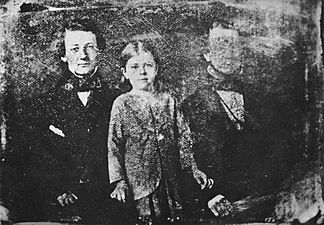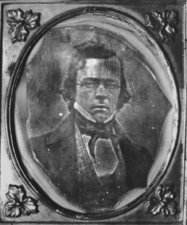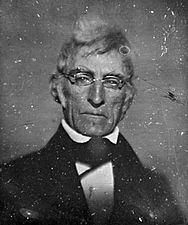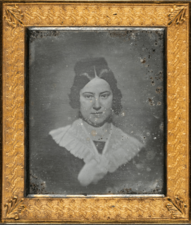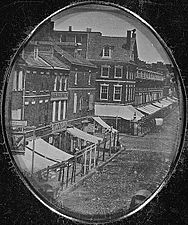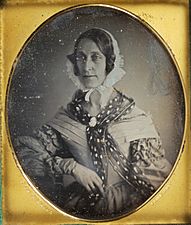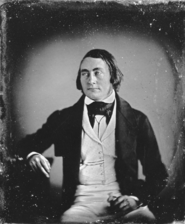Robert Cornelius facts for kids
Quick facts for kids
Robert Cornelius
|
|
|---|---|
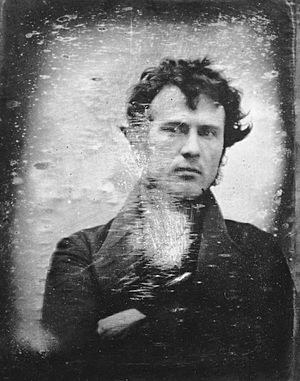
Cornelius' 1839 self-portrait, generally accepted as the earliest photographic portrait, although earlier claims exist.
|
|
| Born | March 1, 1809 Philadelphia, Pennsylvania, U.S.
|
| Died | August 10, 1893 (aged 84) Frankford, Philadelphia, Pennsylvania, U.S.
|
| Resting place | Laurel Hill Cemetery |
| Nationality | American |
| Occupation | Photographer, lamp manufacturer |
| Spouse(s) |
Harriet Comly
(m. 1832; d. 1884) |
| Children | 8 |
Robert Cornelius (born March 1, 1809 – died August 10, 1893) was an American photographer. He was a true pioneer in the early days of photography. His self-portrait from 1839 is famous. It is often called the first photographic portrait of a person taken in the United States.
Between 1840 and 1842, he opened some of the very first photography studios in the U.S. He also found new ways to take pictures faster. This made it much easier to take portraits. Besides photography, Robert Cornelius was also an inventor and a successful businessman. He made and sold lamps. In 1843, he invented the "solar lamp." This lamp burned brighter and used cheaper lard instead of expensive whale oil.
Contents
Early Life and Work
Robert Cornelius was born in Philadelphia. His father, Christian Cornelius, came from Amsterdam. He first worked with silver before starting a company that made lamps. Robert went to a private school when he was young. He was very interested in chemistry. In 1831, he started working for his father. He became very skilled at working with silver and polishing metals.
Photography's Start
In late 1839, a new way of taking pictures called the daguerreotype became known. Soon after, another photographer named Joseph Saxton took a picture of a school in Philadelphia. This was one of the first photos taken in the United States. Saxton then asked Cornelius for help to make better daguerreotype plates. This meeting made Cornelius very curious about photography.
Around October 1839, Cornelius built his own simple camera. He used it to take his first daguerreotype. It was a self-portrait taken outside his family's store. He had to stand still for 10 to 15 minutes for the picture. This amazing photo still exists today! Other early pictures he took of his family have not been saved.
A French photographer named Louis Daguerre took a picture in Paris a year or two earlier. It accidentally showed two people on the street. But Cornelius's self-portrait is usually seen as the first time someone intentionally took a photo of a person in the U.S. However, some people claim earlier photo portraits were made in Europe and the U.S. as far back as 1837.

At first, Cornelius did not make a big deal about his achievement. But a student from his studio, Marcus Aurelius Root, helped keep his story alive. Root wrote a book called The Camera and The Pencil. This book shared the early history of photography in the U.S. The book was shown at a big exhibition in Philadelphia in 1876. There, it caught the eye of Julius Sachse, a famous Philadelphia photographer. Sachse began talking to Cornelius and others to record the history of photography. Cornelius told Sachse he started taking photos in October 1839. But there was no proof until 1975. That's when a librarian found Cornelius's photos from 1839.
Cornelius worked with a chemist named Paul Beck Goddard. Together, they made big improvements. They found ways to make daguerreotypes take much less time. They used a chemical called bromine and better plates. They also used reflectors and blue glass filters to improve the light. Because of their work, taking a portrait took less than a minute!
In May 1840, Cornelius opened his own photography studio. It was the first in Philadelphia. It was also only the second in the world. The first was in New York. Cornelius had visited that studio earlier in 1840.
Cornelius's studio became very popular. Many rich people wanted their pictures taken there. Many of his portraits of famous people are still around today. He opened a second studio from 1841 to 1842. As photography became more popular, more studios opened. Cornelius either lost interest or realized he could earn more money in his family's lamp business.
Later Inventions
Robert Cornelius took over his family's company, Cornelius & Co. (later called Cornelius & Baker). He had great success with his invention, the "solar lamp." At that time, lamps used expensive whale oil. Cornelius improved a British lamp design. His design pushed more air into the burner. This allowed the lamp to burn cheaper lard instead of whale oil.
He received a U.S. patent for the "solar lamp" in 1843. This lamp became very popular. It was sold in the U.S. and Europe. Two large factories in Philadelphia made these lamps. Cornelius also received patents for lighting gaslights with electric sparks. His company also made the first kerosene lamp. However, other companies soon made cheaper and better versions. Even though Cornelius was still wealthy, his lamp company was eventually taken over by others.
Family Life
Robert Cornelius married Harriet Comly in 1832. They had eight children together: three sons and five daughters.
Cornelius retired from his family's business in 1877. In his later years, he lived at his home in Frankford, Philadelphia. He was also an elder at the Presbyterian Church for fifty years.
He passed away at his Frankford home on August 10, 1893. He was buried at Laurel Hill Cemetery.
Daguerreotypes by Cornelius



